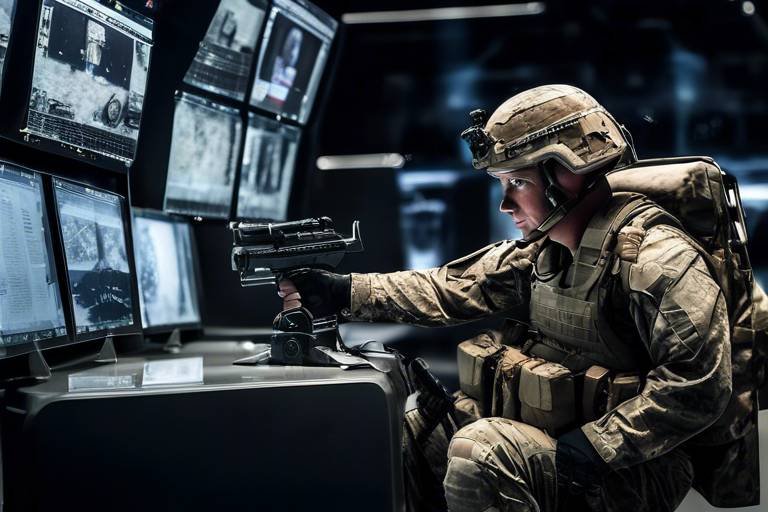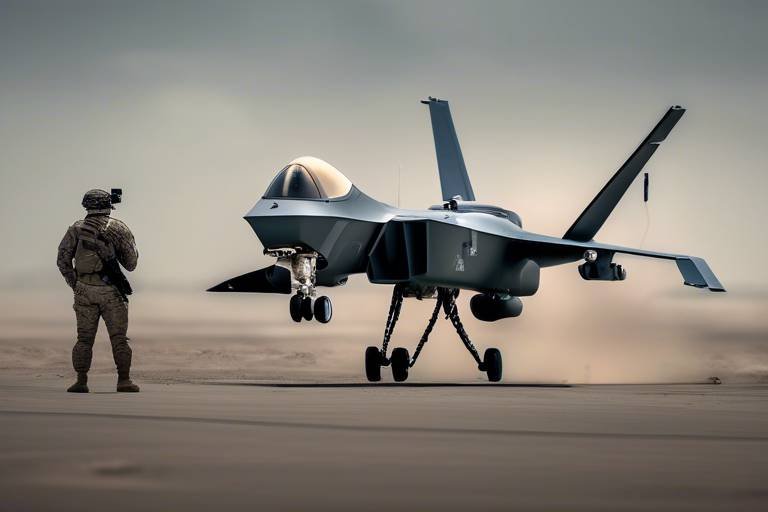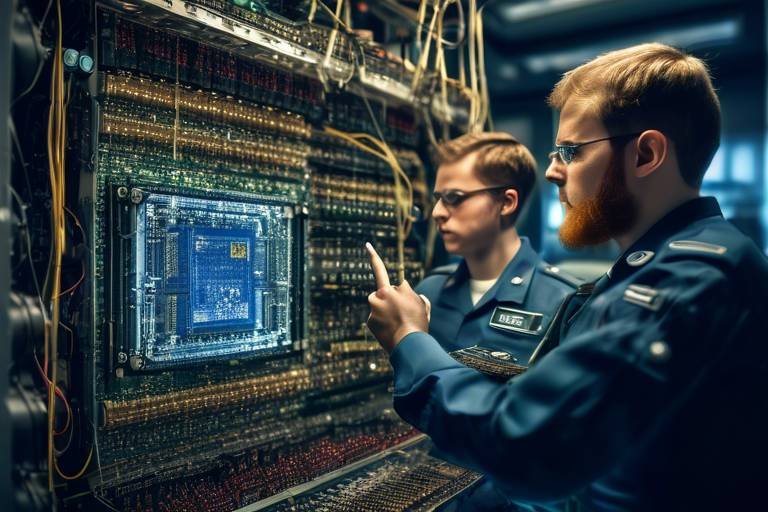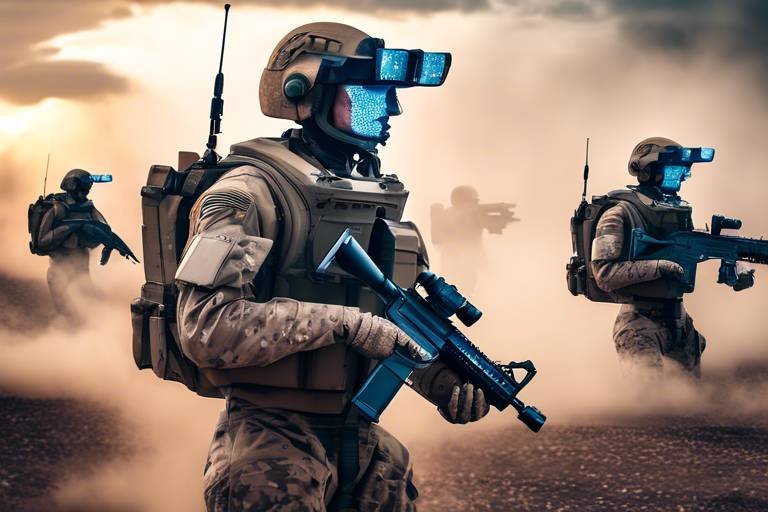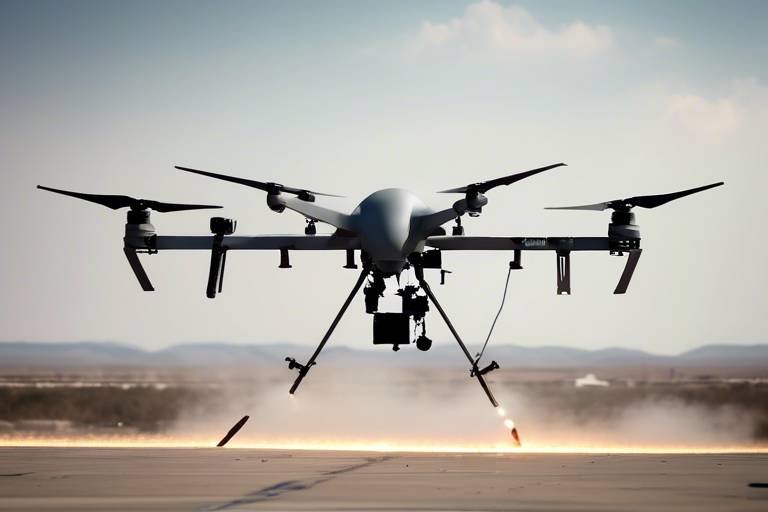The Role of AI in Advancing Anti-Missile Defense Systems
In an era where threats can emerge in the blink of an eye, the integration of artificial intelligence into anti-missile defense systems is nothing short of revolutionary. Imagine a world where military personnel can detect, analyze, and respond to missile threats faster than ever before. This isn't just a dream—it's becoming a reality thanks to AI. By enhancing detection capabilities, improving response times, and increasing overall effectiveness, AI is reshaping how we think about missile defense. As we delve deeper into this topic, you’ll discover how AI is not just a tool but a game-changer in modern military operations.
One of the most significant advancements that AI brings to the table is its ability to enhance the accuracy and speed of missile detection. Traditional systems often struggle with false alarms, which can lead to unnecessary panic and resource allocation. However, AI technologies are designed to improve this aspect dramatically. By employing sophisticated algorithms, these systems can quickly identify potential threats while filtering out benign objects. This means that military forces can focus their efforts on genuine risks, thereby reducing the chance of misallocation of resources.
In the heat of battle, timing is everything. The integration of AI enables real-time analysis of vast amounts of data, allowing military personnel to make rapid decisions during critical situations. Imagine a scenario where multiple missile threats are detected simultaneously. AI can analyze trajectories, assess potential impacts, and recommend the best course of action—all in a matter of seconds. This capability not only enhances the responsiveness of anti-missile systems but also provides a critical edge in fast-paced military operations.
At the heart of AI's transformative power in missile defense are machine learning algorithms. These algorithms learn from past engagements, refining detection capabilities and predicting missile trajectories with remarkable accuracy. For instance, by analyzing previous missile launches, the system can identify patterns and adjust its interception strategies accordingly. This means that each engagement not only serves as a defense mechanism but also as a learning opportunity, making future responses even more effective.
Adaptive learning techniques are another crucial element in this AI-driven evolution. These systems continuously evolve, adjusting their parameters based on new data and experiences. Think of it as a defense system that grows smarter over time, much like a seasoned soldier who learns from each battle. This adaptability significantly increases the effectiveness of missile defense systems, allowing them to stay relevant in an ever-changing threat landscape.
One of the standout features of AI is its ability to recognize patterns. AI-driven pattern recognition helps identify missile launch signatures, enabling defense systems to distinguish between actual threats and harmless objects. This capability is akin to a seasoned detective who can spot a criminal in a crowd. By enhancing operational efficiency, AI ensures that the focus remains on genuine threats, improving overall mission success rates.
Integrating AI with existing missile defense systems enhances their capabilities without necessitating complete overhauls. This is crucial for military organizations looking to maximize their investments in technology. With AI, even older systems can become more effective, ensuring that defense strategies remain robust and relevant in the face of evolving threats.
AI doesn't just enhance technology; it also empowers military personnel to make informed decisions. By providing actionable insights derived from complex data analysis, AI improves strategic responses to missile threats. Imagine having a trusted advisor who can sift through mountains of data and present you with the most critical information at a moment's notice. This capability allows military leaders to focus on strategy while AI handles the data crunching.
Training is vital in military operations, and AI-powered simulations provide realistic environments for military personnel to practice responses to missile threats. These simulations mimic real-world scenarios, allowing soldiers to hone their skills and improve their readiness. It's like a pilot using a flight simulator to prepare for all possible situations before taking to the skies. With AI, training becomes more effective, ensuring that personnel are well-prepared for any challenge that may arise.
Finally, AI facilitates collaboration among various defense systems, enabling them to share information and coordinate responses. This creates a more robust and unified defense against missile threats. Picture a well-coordinated team where every member knows their role and can act swiftly in response to any situation. With AI, defense networks can operate seamlessly, enhancing overall mission success.
Looking ahead, the future of missile defense systems will likely see further advancements in AI, including autonomous systems and enhanced predictive capabilities. These innovations will shape the landscape of military defense strategies, ensuring that nations remain prepared for the challenges of tomorrow. As AI continues to evolve, it will undoubtedly play a pivotal role in safeguarding our skies.
- How does AI improve missile detection? AI enhances missile detection by using advanced algorithms that increase accuracy and reduce false alarms.
- What role do machine learning algorithms play? Machine learning algorithms analyze past engagements to refine detection capabilities and predict missile trajectories.
- Can AI integrate with existing defense systems? Yes, AI can enhance existing systems without the need for complete overhauls, making them more effective.
- What are the future trends in AI and missile defense? Future trends include the development of autonomous systems and improved predictive capabilities.

AI-Powered Detection Systems
In the realm of modern warfare, the speed and accuracy of missile detection can mean the difference between safety and catastrophe. AI technologies are revolutionizing this landscape, enhancing the capabilities of anti-missile systems to identify threats more efficiently than ever before. Imagine a world where defense systems can discern a missile from a harmless bird in the blink of an eye—this is not just a dream but a reality being shaped by artificial intelligence.
One of the core benefits of AI in detection systems is its ability to significantly reduce false alarms. Traditional systems often struggled with distinguishing between genuine threats and benign objects, leading to unnecessary panic and resource allocation. However, with the implementation of advanced algorithms, AI can analyze patterns and behaviors, allowing for a more nuanced understanding of incoming objects. This not only improves the reliability of alerts but also enables military personnel to focus their attention on real threats, thereby optimizing resource deployment.
To illustrate this further, consider the following table that highlights the comparison between traditional detection systems and AI-powered systems:
| Feature | Traditional Systems | AI-Powered Systems |
|---|---|---|
| Detection Speed | Moderate | High |
| False Alarm Rate | High | Low |
| Data Processing | Limited | Extensive |
| Adaptability | Low | High |
As the table suggests, the leap from traditional systems to AI-powered solutions is monumental. The ability to process vast amounts of data in real-time is another game-changer. AI can sift through countless data points, recognizing patterns and anomalies that would be impossible for a human operator to detect in a timely manner. This capability allows for quicker identification of incoming threats, enabling defense systems to respond almost instantaneously.
Moreover, AI's role extends beyond just detection; it also enhances the overall operational efficiency of missile defense systems. By continuously learning and adapting, AI can refine its detection algorithms based on past engagements. This adaptive learning means that the system becomes smarter with each encounter, improving its ability to predict missile trajectories and optimize interception strategies. It's akin to a seasoned chess player who learns from each game, becoming more strategic and insightful with every move.
In summary, AI-powered detection systems are not just an upgrade; they represent a fundamental shift in how military operations approach missile threats. With enhanced accuracy, reduced false alarms, and the capability for real-time data processing, these systems are paving the way for a more secure future in defense operations. As we continue to innovate and integrate AI into military technology, the potential for saving lives and protecting nations grows exponentially.
- How does AI reduce false alarms in missile detection?
AI utilizes advanced algorithms to analyze the behavior and patterns of incoming objects, allowing it to differentiate between actual threats and benign entities. - What role does real-time data processing play in missile defense?
Real-time data processing enables rapid analysis and decision-making, allowing defense systems to respond swiftly to threats as they arise. - Can AI systems learn from past engagements?
Yes, AI systems employ adaptive learning techniques that allow them to refine their detection capabilities based on historical data and past encounters.

Real-Time Data Processing
In the fast-paced world of military operations, is nothing short of a game changer. Imagine a scenario where a missile is launched; every second counts. With traditional systems, the lag in data processing could mean the difference between interception and catastrophe. However, by integrating artificial intelligence into anti-missile defense systems, we can significantly enhance the speed and efficiency of data analysis, providing military personnel with crucial insights in the blink of an eye.
AI algorithms are designed to sift through vast amounts of data rapidly, identifying patterns and anomalies that human operators might overlook. This capability allows for instantaneous threat assessments, ensuring that defense systems react swiftly to emerging threats. For instance, when a missile is detected, the AI system can analyze trajectories, launch points, and potential impact zones almost instantly, allowing for a coordinated response that is both precise and timely.
One of the most remarkable aspects of real-time data processing is its ability to adapt to changing conditions. In a battlefield scenario, variables such as weather, terrain, and enemy tactics can shift rapidly. AI systems can continuously update their models based on incoming data, ensuring that decisions are made based on the most current information available. This adaptability is akin to a skilled chess player who anticipates moves and adjusts strategies in real-time, thereby increasing the likelihood of success.
Moreover, the integration of AI-driven data processing enhances the capabilities of existing systems without necessitating a complete overhaul. This means that military forces can leverage their current investments while still benefiting from cutting-edge technology. For example, older radar systems can be enhanced with AI algorithms that interpret incoming data more effectively, leading to improved detection rates and reduced false alarms. In this way, AI acts as a powerful ally, augmenting traditional systems rather than replacing them.
To illustrate the impact of real-time data processing, consider the following table that compares traditional data processing methods with AI-enhanced systems:
| Feature | Traditional Systems | AI-Enhanced Systems |
|---|---|---|
| Data Processing Speed | Slow, often resulting in delays | Instantaneous, facilitating quick responses |
| Accuracy | Prone to human error | High accuracy through machine learning |
| Adaptability | Limited, requires manual updates | Dynamic, learns and adapts continuously |
| Integration | Often requires complete system upgrades | Enhances existing systems without overhaul |
In summary, the integration of through AI not only improves the effectiveness of anti-missile defense systems but also ensures that military personnel are equipped with the best tools for modern warfare. As we continue to explore the potential of AI, it is evident that the future of military defense will be shaped by these advancements, leading to more secure and responsive operations.
- What is real-time data processing in missile defense?
Real-time data processing refers to the ability of systems to analyze incoming data and respond almost instantaneously, critical for intercepting threats like missiles. - How does AI improve detection capabilities?
AI enhances detection by rapidly analyzing data, identifying patterns, and learning from past engagements to predict future threats. - Can existing systems benefit from AI integration?
Yes, AI can be integrated into existing missile defense systems, enhancing their capabilities without the need for complete overhauls. - What role does adaptability play in military operations?
Adaptability allows systems to adjust to changing battlefield conditions, ensuring that decisions are based on the most current information.

Machine Learning Algorithms
When we talk about , we’re diving into a world where computers learn from data and improve over time without being explicitly programmed. In the context of anti-missile defense systems, these algorithms are nothing short of revolutionary. Imagine having a system that not only detects missiles but also learns from each encounter, becoming smarter and more efficient with every engagement. This is the power of machine learning.
At the heart of these algorithms is the ability to analyze vast amounts of data, identifying patterns and making predictions that were previously impossible. For instance, when a missile is launched, the system can assess its trajectory based on historical data and current environmental conditions. It’s like having a seasoned pilot who knows the skies intimately, able to predict the best course of action in a split second. This capability significantly enhances interception strategies, allowing for timely and precise responses to threats.
One of the remarkable features of machine learning algorithms is their adaptive learning capabilities. These algorithms continuously refine their models based on new data inputs. For example, if a new type of missile is detected, the system can quickly learn its characteristics and adjust its detection parameters accordingly. This adaptability ensures that the defense systems remain effective against emerging threats, making them a step ahead of potential adversaries.
Moreover, machine learning algorithms excel in pattern recognition. They can sift through enormous datasets to identify missile launch signatures, distinguishing between genuine threats and harmless objects. This capability is crucial in modern warfare, where the margin for error is razor-thin. By minimizing false alarms, military personnel can focus their resources on actual threats, optimizing their response strategies and operational efficiency.
In summary, the integration of machine learning algorithms into anti-missile defense systems is a game-changer. It not only enhances detection and interception capabilities but also ensures that these systems evolve over time, adapting to new challenges in the ever-changing landscape of military operations. As we look to the future, it’s clear that the synergy between AI and machine learning will continue to shape the effectiveness of our defense strategies.
- What are machine learning algorithms? - Machine learning algorithms are systems that learn from data to improve their performance over time without being explicitly programmed.
- How do these algorithms enhance missile defense systems? - They analyze data to predict missile trajectories, adapt to new threats, and improve detection accuracy.
- Can machine learning algorithms reduce false alarms? - Yes, they can help distinguish between actual threats and benign objects, thus minimizing false alarms.
- What is adaptive learning in this context? - Adaptive learning allows algorithms to refine their models based on new data, ensuring systems remain effective against emerging threats.

Adaptive Learning Techniques
This article explores how artificial intelligence is transforming anti-missile defense systems, enhancing detection, response times, and overall effectiveness against modern threats in military operations.
AI technologies improve the accuracy and speed of missile detection, allowing for quicker identification of threats and reducing the risk of false alarms in defense systems.
The integration of AI enables real-time analysis of vast amounts of data, facilitating rapid decision-making and enhancing the responsiveness of anti-missile systems during critical situations.
Machine learning algorithms play a crucial role in refining detection capabilities, learning from past engagements to predict missile trajectories and improve interception strategies.
Adaptive learning techniques represent a groundbreaking advancement in the realm of anti-missile defense systems. Imagine a system that doesn't just follow pre-set instructions but learns and evolves based on its experiences. This is precisely what adaptive learning offers. By continuously analyzing new data and outcomes, these systems adjust their methods and parameters, enhancing their effectiveness over time. For instance, if a missile defense system encounters a new type of missile or a novel launch pattern, it can modify its response strategy based on this encounter, thereby improving its chances of successful interception in future scenarios.
Moreover, adaptive learning techniques can significantly reduce the time needed for systems to adapt to changing environments. Instead of relying solely on human operators to update protocols or strategies, the system autonomously refines its algorithms. This not only accelerates the response time but also ensures that the defense mechanisms remain relevant against evolving threats. Think of it as a student who learns from each test: the more they practice, the better they become. In the same way, adaptive learning enhances the system's performance through continuous improvement.
To illustrate how adaptive learning techniques function in missile defense, consider the following table:
| Aspect | Traditional Systems | Adaptive Learning Systems |
|---|---|---|
| Response Time | Fixed protocols | Dynamic adjustments |
| Learning Capability | Static updates | Continuous learning |
| Effectiveness | Limited to known threats | Adapts to new threats |
This table highlights the stark differences between traditional missile defense systems and those utilizing adaptive learning techniques. The latter not only enhances operational efficiency but also ensures that military forces can stay one step ahead of potential adversaries.
Integrating AI with existing missile defense systems enhances their capabilities without the need for complete overhauls, ensuring that investments in technology remain relevant and effective.
AI assists military personnel in making informed decisions by providing actionable insights derived from complex data analysis, ultimately improving strategic responses to missile threats.
AI-powered simulations provide realistic training environments for military personnel, allowing them to practice responses to missile threats and improve their readiness and effectiveness in real-world scenarios.
AI facilitates collaboration among various defense systems, enabling them to share information and coordinate responses, thus creating a more robust and unified defense against missile threats.
The future of missile defense systems will likely see further advancements in AI, including autonomous systems and enhanced predictive capabilities, shaping the landscape of military defense strategies.
- What are adaptive learning techniques in missile defense?
Adaptive learning techniques allow missile defense systems to learn from past experiences and continuously improve their response strategies based on new data.
- How does AI improve missile detection?
AI enhances missile detection by increasing the speed and accuracy of threat identification while minimizing false alarms.
- Can existing missile defense systems be upgraded with AI?
Yes, AI can be integrated with existing systems, enhancing their capabilities without requiring complete overhauls.

Pattern Recognition
In the realm of missile defense, serves as a pivotal technology that significantly enhances operational efficiency. Imagine trying to find a needle in a haystack; that’s what military personnel face when it comes to identifying missile threats among countless objects in the sky. AI-driven pattern recognition acts as a sophisticated tool that sifts through this 'haystack'—analyzing data and recognizing specific launch signatures that indicate an imminent missile launch. By employing advanced algorithms, these systems can distinguish between genuine threats and benign objects, such as birds or debris, which is crucial in reducing the number of false alarms that can lead to unnecessary military responses.
One of the remarkable aspects of AI-based pattern recognition is its ability to learn and adapt. As it processes more data, it refines its understanding of what constitutes a missile threat. This capability is akin to how we learn from experience; the more we encounter different situations, the better we become at recognizing patterns and making informed decisions. In a military context, this means that as the system encounters various missile types and launch conditions, it becomes increasingly adept at identifying potential threats quickly and accurately.
Moreover, the implications of effective pattern recognition extend beyond just detection. It enhances the overall response strategy by providing crucial information to military operators. For instance, when a missile launch is detected, the system can analyze the trajectory and speed, offering real-time data that can influence interception strategies. This ability to predict the path of a missile can drastically improve the chances of a successful interception, making the defense system not just reactive but also proactive.
To illustrate the impact of pattern recognition, consider the following table that summarizes key benefits:
| Benefit | Description |
|---|---|
| Increased Accuracy | Reduces false positives by distinguishing between actual threats and non-threatening objects. |
| Faster Response | Enables quicker identification of missile launches, allowing for timely defensive measures. |
| Enhanced Decision-Making | Provides critical data for military operators to make informed strategic choices. |
| Adaptive Learning | Continuously improves detection capabilities based on new data and experiences. |
In essence, is not just a technological advancement; it’s a game-changer in the field of missile defense. By harnessing the power of AI, military forces can significantly enhance their operational readiness and effectiveness against modern threats. As these systems evolve, we can anticipate even greater improvements in how we protect against missile attacks, ensuring that our defenses remain robust in the face of ever-evolving challenges.
- What is pattern recognition in missile defense?
Pattern recognition refers to the ability of AI systems to identify specific signatures or characteristics of missile launches, helping to distinguish between real threats and non-threatening objects. - How does AI improve pattern recognition?
AI enhances pattern recognition by using machine learning algorithms that analyze vast amounts of data, allowing systems to learn from past experiences and refine their detection capabilities. - What are the benefits of improved pattern recognition?
Improved pattern recognition leads to increased accuracy, faster response times, enhanced decision-making, and adaptive learning capabilities for missile defense systems. - Can pattern recognition reduce false alarms?
Yes, by effectively distinguishing between genuine threats and benign objects, AI-driven pattern recognition significantly reduces the incidence of false alarms in missile defense systems.

Integration with Existing Systems
In the rapidly evolving landscape of military technology, the integration of artificial intelligence (AI) with existing missile defense systems is nothing short of revolutionary. Imagine trying to upgrade your smartphone without losing all your data; that’s the kind of challenge military engineers face when enhancing defense capabilities. The beauty of AI lies in its ability to augment current systems rather than replace them entirely, ensuring that investments made in technology continue to provide value over time.
One of the most significant advantages of integrating AI is that it allows for a seamless enhancement of existing infrastructure. Rather than undergoing a complete overhaul, which can be costly and time-consuming, military organizations can implement AI solutions that work alongside their current systems. This integration can lead to improved detection rates and faster response times, significantly boosting the overall effectiveness of missile defense operations.
For instance, consider a scenario where a traditional radar system is in place. By incorporating AI algorithms, the radar can become more adept at distinguishing between various objects in the sky—such as friendly aircraft, weather balloons, and actual missile threats. This capability is crucial because it reduces the likelihood of false alarms, allowing military personnel to focus on genuine threats without the distraction of unnecessary alerts.
Moreover, the integration process is often facilitated by the use of modular architectures. These architectures allow for the addition of new AI modules that can enhance specific functionalities, such as data processing or threat analysis. This modular approach not only simplifies the integration process but also provides flexibility for future upgrades. As new AI technologies emerge, military systems can adapt without needing a complete redesign.
Furthermore, the integration of AI with existing systems fosters better interoperability among various defense platforms. Different systems can share critical information in real-time, creating a cohesive network that enhances situational awareness and response capabilities. For example, if one radar system detects a missile launch, it can quickly relay this information to other systems, allowing for a coordinated defense response. This collaborative approach is essential in modern warfare, where threats can emerge and evolve rapidly.
In summary, the integration of AI with existing missile defense systems is a game-changer. By enhancing current capabilities without the need for extensive overhauls, military forces can ensure that their defense strategies remain relevant and effective against evolving threats. As technology continues to advance, the potential for AI in this field is boundless, paving the way for a more secure future.
- How does AI improve missile detection?
AI enhances missile detection by analyzing data faster and more accurately, allowing for quicker identification of threats and reducing false alarms. - Can AI be integrated with older missile defense systems?
Yes, AI can be integrated with existing systems through modular architectures, enhancing their capabilities without requiring complete overhauls. - What role do machine learning algorithms play?
Machine learning algorithms refine detection capabilities by learning from past engagements, predicting trajectories, and improving interception strategies. - How does AI facilitate collaboration among defense systems?
AI enables different systems to share information in real-time, creating a unified defense network that enhances overall effectiveness against missile threats.

Enhanced Decision-Making
In the high-stakes world of military operations, decision-making can mean the difference between success and failure. With the advent of artificial intelligence, the landscape of decision-making is undergoing a profound transformation. AI systems analyze vast amounts of data at lightning speed, providing military personnel with actionable insights that are not just timely but also incredibly accurate. Imagine trying to find a needle in a haystack, but instead of searching blindly, you have a magnet that pulls the needle right to you. That’s the power AI brings to the table.
One of the most significant advantages of AI in decision-making is its ability to sift through complex data sets to identify patterns and trends. For instance, AI algorithms can analyze historical data from previous missile launches, identifying factors that led to successful interceptions or failures. This analysis enables military strategists to make informed decisions based on empirical evidence rather than gut feelings. The result? A more strategic and calculated approach to missile defense that enhances overall effectiveness.
Furthermore, AI can simulate various scenarios, allowing military leaders to visualize potential outcomes before making critical decisions. These simulations can include a variety of factors such as weather conditions, enemy tactics, and available resources. By running these simulations, decision-makers can evaluate the effectiveness of different strategies and choose the most promising one. It's like playing a game of chess where you can see all the possible moves and their consequences before making your play.
To illustrate how AI enhances decision-making, consider the following table that outlines the key benefits:
| Benefit | Description |
|---|---|
| Speed | AI processes data rapidly, enabling quick responses to emerging threats. |
| Accuracy | Advanced algorithms reduce the chances of human error, ensuring better decision quality. |
| Scenario Analysis | Simulations allow military personnel to visualize outcomes and strategize effectively. |
| Data Synthesis | AI synthesizes information from various sources, providing a comprehensive view of the battlefield. |
Moreover, AI aids in collaborative decision-making by facilitating communication among different defense systems. When each system can share real-time data, it creates a unified front against potential missile threats. This interconnectedness ensures that all units are on the same page, allowing for coordinated responses that are far more effective than isolated actions. Picture a well-rehearsed orchestra where every musician knows their part and plays in harmony—this is the kind of precision AI brings to military operations.
As we look to the future, the role of AI in enhancing decision-making is only set to grow. With advancements in machine learning and data analytics, we can expect even more sophisticated tools that empower military personnel to make decisions with unparalleled confidence. The integration of AI into decision-making processes not only improves operational efficiency but also enhances the safety and effectiveness of military missions.
- How does AI improve decision-making in military operations?
AI analyzes vast datasets quickly, providing actionable insights that help military personnel make informed decisions. - What role do simulations play in decision-making?
Simulations allow military leaders to visualize potential outcomes and evaluate strategies before making decisions. - Can AI reduce the risk of human error?
Yes, AI algorithms are designed to minimize human error, ensuring better accuracy in decision-making. - How does AI facilitate collaboration among defense systems?
AI enables different systems to share real-time data, creating a more unified response to threats.

Simulation and Training
In the ever-evolving landscape of military defense, powered by artificial intelligence (AI) are becoming indispensable tools. Imagine a world where military personnel can engage in realistic training scenarios that mimic actual missile threats, all while analyzing their performance in real-time. This is not just a dream; it's a reality that AI is making possible. By leveraging advanced algorithms, military training programs can create dynamic environments that adapt based on the actions of the trainees, allowing them to experience a wide range of scenarios without the risks associated with live exercises.
AI-driven simulations enable military personnel to practice their responses to missile threats in a safe and controlled setting. These simulations can incorporate realistic environmental factors such as weather conditions, terrain variations, and enemy tactics, providing a comprehensive training experience. For instance, trainees can engage in virtual exercises where they must identify and intercept incoming missiles while managing limited resources and time constraints. This not only sharpens their skills but also enhances their ability to make quick, informed decisions under pressure.
Moreover, the feedback provided by AI systems during these training exercises is invaluable. After each simulation, trainees receive detailed analyses of their performance, highlighting areas for improvement. This feedback loop allows them to refine their strategies and tactics continuously. By analyzing data from past exercises, AI can even suggest personalized training regimens tailored to each individual's strengths and weaknesses. It's like having a personal coach that never sleeps!
Furthermore, the integration of AI in training programs fosters a culture of collaboration and teamwork. Through networked simulations, multiple teams can participate in joint exercises, allowing them to coordinate their responses to missile threats effectively. This collaborative approach not only builds camaraderie among team members but also prepares them for real-world scenarios where coordination is crucial. Imagine a scenario where different branches of the military must work together to neutralize a missile threat; the training they undergo through AI simulations can make all the difference.
As we look toward the future, the potential for AI in simulation and training is vast. The technology will continue to advance, leading to even more immersive and interactive training environments. With the integration of virtual reality (VR) and augmented reality (AR), the training experience will become more lifelike, further enhancing the preparedness of military personnel. In this rapidly changing world, staying ahead of the curve is essential, and AI-powered training is a key component in achieving that goal.
- How does AI improve military training simulations?
AI enhances military training simulations by creating adaptive environments that respond to trainee actions, providing real-time feedback, and analyzing performance to suggest improvements. - Can AI simulations replicate real-world scenarios?
Yes, AI simulations can incorporate various environmental factors and enemy tactics to closely mirror real-world missile threat scenarios, ensuring trainees are well-prepared. - What are the benefits of collaborative training with AI?
Collaborative training with AI allows different teams to practice coordinating responses to threats, fostering teamwork and improving overall effectiveness in real-world operations. - Will AI continue to evolve in military training?
Absolutely! The integration of technologies like virtual reality and augmented reality will further enhance AI's role in military training, making it even more immersive and effective.

Collaborative Defense Networks
In the ever-evolving landscape of military technology, are becoming a game-changer in the realm of anti-missile defense systems. Imagine a web of interconnected systems, each capable of sharing vital information in real-time, creating a formidable shield against missile threats. This collaboration is not just about individual systems functioning in isolation; it's about leveraging the strengths of various platforms to create a more comprehensive and effective defense strategy.
One of the most compelling aspects of collaborative defense networks is their ability to enhance situational awareness. When different defense systems—from ground-based interceptors to aerial drones—can communicate and share data, military personnel gain a clearer picture of the battlefield. This interconnectedness allows for a quicker response to threats, as systems can work together to track and intercept missiles more effectively. For instance, if a missile is detected by a satellite, that information can be immediately relayed to ground-based systems, enabling them to prepare for interception.
Moreover, these networks facilitate coordinated responses to missile threats. By integrating AI algorithms, collaborative defense networks can analyze incoming data from multiple sources, prioritizing threats based on their trajectory and potential impact. This means that instead of reacting to threats in a piecemeal fashion, military forces can deploy a unified response, optimizing the chances of successful interception. For example, if a missile is launched from a specific location, multiple defense systems can be alerted simultaneously, allowing for a synchronized response that maximizes interception efficacy.
Another significant advantage is the reduction of operational costs. By utilizing existing systems and enhancing their capabilities through collaboration, military forces can avoid the need for expensive overhauls or complete replacements. This not only preserves budgetary resources but also ensures that the technology remains relevant in the face of evolving threats. The integration of AI into these networks allows for continuous updates and improvements without the need for extensive downtime or retraining.
As we look to the future, the potential for collaborative defense networks is vast. With advancements in AI and machine learning, these systems will likely become even more sophisticated, enabling seamless communication and coordination across various platforms. The integration of autonomous systems could further enhance these networks, allowing for real-time decision-making without human intervention, which could be crucial in high-stakes scenarios.
In conclusion, collaborative defense networks represent a significant leap forward in anti-missile defense systems. By fostering communication and coordination among various platforms, these networks enhance situational awareness, optimize responses, and reduce operational costs, paving the way for a more secure future. As military technology continues to advance, the importance of collaboration in defense strategies will only grow, ensuring that nations are better equipped to face emerging threats.
- What are collaborative defense networks? Collaborative defense networks are systems that allow various military platforms to communicate and share information in real-time, enhancing their collective response to missile threats.
- How do collaborative defense networks improve missile interception? By integrating data from multiple sources, these networks enable coordinated responses, optimizing the chances of successful interception.
- What role does AI play in collaborative defense networks? AI enhances decision-making by analyzing data quickly and accurately, allowing for real-time responses to missile threats.
- Are collaborative defense networks cost-effective? Yes, they reduce operational costs by enhancing existing systems rather than requiring complete overhauls or replacements.

Future Trends in AI and Missile Defense
The realm of missile defense is on the brink of a revolution, and at the heart of this transformation is artificial intelligence. As we look to the future, it's clear that AI will not only enhance current systems but also fundamentally change how we approach defense strategies. Imagine a world where missile defense systems can predict threats before they even emerge. This isn't science fiction; it's the direction in which we are heading. With advancements in AI, we can expect a surge in autonomous systems that operate with minimal human intervention, making split-second decisions that could save countless lives.
One of the most exciting prospects is the development of predictive analytics. By leveraging vast amounts of data, AI algorithms can forecast missile trajectories with unprecedented accuracy. This means that instead of reacting to a threat, defense systems will be able to proactively engage, potentially neutralizing threats before they reach their targets. Picture this: a missile is launched, and within seconds, an AI system analyzes its trajectory, calculates its impact point, and coordinates a response. This kind of rapid response capability could be a game-changer in military operations.
Moreover, we can expect to see an increase in collaborative defense networks. As different defense systems become interconnected through AI, they will be able to share real-time data and coordinate their responses. This collective intelligence will create a more robust defense mechanism, akin to a flock of birds that moves as one, adapting to threats in a fluid and dynamic manner. The synergy of these systems will not only enhance their individual capabilities but will also create a unified front against missile threats.
Another trend to watch is the incorporation of machine learning in training simulations. Future military personnel will engage in highly realistic training environments powered by AI, where they can practice and refine their responses to various missile threats. These simulations will adapt based on the performance of the trainees, ensuring that they are always prepared for the unexpected. Training will become more effective, as personnel can experience a wide range of scenarios without the risks associated with live exercises.
It's also important to consider the ethical implications of these advancements. As AI takes on more decision-making roles in missile defense, we must grapple with questions about accountability and oversight. Who is responsible if an autonomous system makes a mistake? How do we ensure that these systems are used responsibly? Addressing these concerns will be crucial as we move forward.
As we venture deeper into the future of AI and missile defense, we stand at a crossroads. The potential for enhanced predictive capabilities and autonomous systems promises a new era of military defense strategies. However, with great power comes great responsibility. The integration of AI must be approached with caution, ensuring that ethical considerations are at the forefront of our advancements.
- What role does AI play in missile defense?
AI enhances detection, response times, and overall effectiveness by analyzing vast amounts of data and predicting missile trajectories. - How will AI change military training?
AI-powered simulations will provide realistic training environments, allowing military personnel to practice responses to missile threats effectively. - What are the ethical concerns surrounding AI in missile defense?
As AI systems take on decision-making roles, questions about accountability and responsible use become crucial to address. - Will AI make missile defense systems autonomous?
Yes, future advancements may lead to more autonomous systems capable of making real-time decisions with minimal human intervention.
Frequently Asked Questions
-
How does AI improve missile detection systems?
AI enhances missile detection systems by utilizing advanced algorithms that analyze data in real-time. This allows for quicker identification of potential threats and significantly reduces the chances of false alarms, ensuring that defense systems remain reliable and efficient.
-
What role do machine learning algorithms play in anti-missile defense?
Machine learning algorithms are pivotal in refining the capabilities of anti-missile defense systems. They learn from historical data and past engagements, enabling the systems to predict missile trajectories more accurately and improve interception strategies over time.
-
Can AI systems adapt to new threats?
Absolutely! AI systems employ adaptive learning techniques that allow them to continuously evolve. By adjusting their parameters based on new data and experiences, they become increasingly effective at countering emerging missile threats.
-
How does AI facilitate decision-making in military operations?
AI assists military personnel by providing actionable insights derived from complex data analysis. This empowers decision-makers to respond more strategically to missile threats, enhancing overall operational effectiveness.
-
What are the benefits of AI-powered simulations for military training?
AI-powered simulations create realistic training environments that help military personnel practice their responses to missile threats. This not only improves their readiness but also enhances their effectiveness in real-world scenarios.
-
How does AI enable collaboration among defense systems?
AI facilitates collaboration by enabling various defense systems to share information and coordinate their responses. This interconnectedness creates a more robust and unified defense against missile threats, maximizing the strengths of each system involved.
-
What future advancements can we expect in AI and missile defense?
The future of missile defense systems is likely to see significant advancements in AI, including the development of autonomous systems and enhanced predictive capabilities. These innovations will shape military defense strategies and improve response mechanisms against missile threats.



